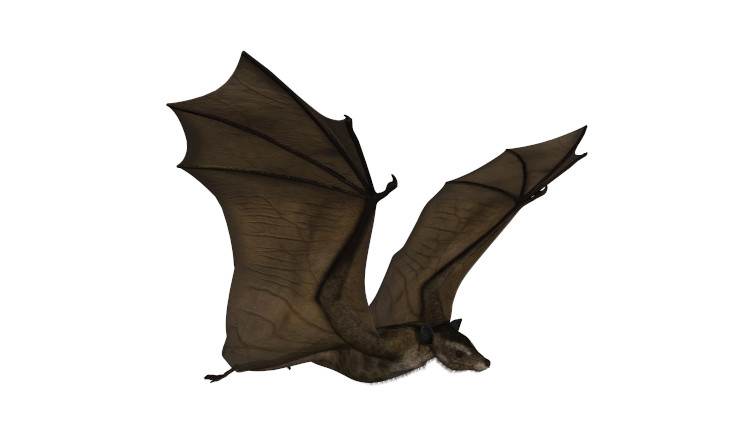Well-preserved bat skeletons found in Wyoming could be the oldest ever discovered.
Dating back over 52 million years, the fossils of Icaronycteris gunnelli offer researchers a deeper look at how the flying mammals evolved.

While their exact age isn't certain, the two skeletons of Icaronycteris gunnelli are thought to be older than any bat's previously found. Image © Rietbergen et al. 2023, licensed under Public Domain via Plos One.
Well-preserved bat skeletons found in Wyoming could be the oldest ever discovered.
Dating back over 52 million years, the fossils of Icaronycteris gunnelli offer researchers a deeper look at how the flying mammals evolved.
An extinct species of bat has been discovered hidden among museum collections.
The new species, Icaronycteris gunnelli, was described from specimens held at the American Museum of Natural History and the Royal Ontario Museum. Both fossils were originally found in Wyoming's Green River Formation, an area renowned for producing some of the world's oldest bats.
While dozens of fossils have been excavated from these rocks, these had represented only two bat species. By describing I. gunnelli, the researchers hope to provide a clearer view of how the only mammals to take to the air evolved.
Tim Rietbergen, the study's lead author, says, 'For many years, bat fossils discovered in this formation were assigned to one of two species, depending on their size. We had heard rumours about a smaller bat species being present, but it took a while before such a specimen was brought to our attention.'
'If we study other Green River fossils in the world's collections, we might find an even higher bat diversity from this location.'
Dr Neil Adams is the Natural History Museum's Curator of Fossil Mammals and was not involved with the study. He adds, 'The early stages of bat evolution are not well understood, so any new fossil skeleton is an important find.'
'It adds to the diversity of early bats, and demonstrates that there must have been a lot of diversification happening earlier in time to explain the number of these early species that we now know of.'
The study was published in the journal Plos One.

The fossils were found in the Green River Formation, which is renowned for preserving well-preserved fossils. Image © Leaflet, licensed under CC BY-SA 4.0 via Wikimedia Commons.
While bats are one of the most diverse groups of mammals alive today, with more than 1400 species, their origins are uncertain. Bats have a notoriously incomplete fossil record, with some studies estimating that as much as 88% of their fossil record is currently missing.
Many of the fossils which have been found are fragmentary, which limits the insights they can provide. Extinct bats such as Australonycteris, for instance, have been described only from teeth and small fragments of bone.
'Bats are small and have very delicate bones, so they're rarely found as complete skeletons,' Neil says. 'Complete skeletons from this early in their evolution, such as those at Green River, are only preserved in very special circumstances.'
'These bats fell to the bottom of a deep lake where conditions, such as oxygen-free waters, prevented scavenging of their carcasses and enabled the preservation of entire articulated skeletons.'
Of the few complete skeletons which have been found, all of them represent animals which are recognisably bat-like and capable of powered flight. While it's almost certain that the ancestors of bats went through several different stages on their route to flight, such as gliding, fossils of these intermediate animals are yet to be found.
'At the moment, we don't have any clear fossils of the ancestors of bats,' Neil says. 'Some research suggests that bat characteristics, like the elongation of digits and arms, could be caused by only a few genetic changes.'
'This means the process could have happened incredibly fast in evolutionary terms and makes it less likely that intermediate stages in bat evolution were captured in the fossil record.'
Instead, scientists have had to make inferences from the skeletons they have. Some early bats, for instance, have a limb structure which appears to be partly adapted for flight, and partly for climbing.
This suggests that their ancestors might have climbed cliffs and trees before gliding off them, using tails for added balance.
For other traits, however, the evidence is not as clear cut. One big question is whether bats evolved flight or echolocation first, or if they developed together.
The challenge of answering this question is best illustrated by another Green River fossil bat, Onychonycteris finneryi. Different interpretations of the same fossil have been used to argue for both echolocation and flight coming first. While fossil evidence tends to favour the flight-first theory, so far there's no definite answer.

Ancient bat species like Icaronycteris were already very recognisable during the Eocene. Image © Andreas Meyer/Shutterstock.
The specimens of Icaronycteris gunnelli were discovered deeper in the Green River Formation than any previously discovered bat skeleton. While the ages of the different layers are not well understood, their position in the rocks suggests these skeletons are the oldest yet found.
Using CT scans of the specimens, the researchers compared the new species to other bats from the Eocene Epoch, which lasted from around 56 to 34 million years ago. It was the smallest bat from the Green River Formation, and had comparatively short forearms and hindlimbs.
These characteristics allowed the team to put together a family tree of these ancient bats, suggesting that they were closely related to Icaronycteris index, a species described from the site in the 1960s.
They were also able to show that two bats which had been tentatively described as species of Icaronycteris were probably from a completely different lineage.
'The specimens from France and India are probably not part of the same family of bats as the Icaronycteris species from Green River, limiting this group's presence to North America,' Neil says. 'This highlights that there were many different lineages of bats diversifying on multiple continents at even this early stage in their evolution.'
The inclusion of I. gunnelli has also rearranged other parts of the family tree. Onychonycteris was previously thought to represent one of the earliest branches, but the new study shows it further up the bat family tree. Finding more fossils will help to firm up these relationships and explain how these North American bats evolved.
'The study suggests there are more species that we haven't yet discovered,' Neil adds. 'Ideally, we would find a site like the Green River from the Paleocene, 5 to 15 million years earlier in time, where we could search for the intermediate forms in bat evolution that must have existed.'
'This would help to clear up some of the mystery surrounding these fascinating animals.'

We're working towards a future where both people and the planet thrive.
Hear from scientists studying human impact and change in the natural world.
Don't miss a thing
Receive email updates about our news, science, exhibitions, events, products, services and fundraising activities. We may occasionally include third-party content from our corporate partners and other museums. We will not share your personal details with these third parties. You must be over the age of 13. Privacy notice.
Follow us on social media